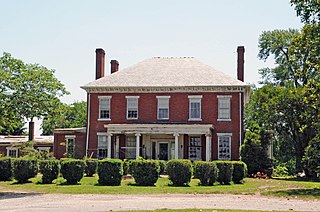
Varina Farms, also known as Varina Plantation or Varina Farms Plantation or Varina on the James, is a plantation established in the 17th century on the James River about 10 miles (16 km) south of Richmond, Virginia. An 820-acre (330 ha) property was listed on the National Register of Historic Places in 1977 as "Varina Plantation". At that time it included two contributing buildings and one other contributing site.

York River State Park is located near the unincorporated town of Croaker in James City County, Virginia on the south bank of the York River about 10 miles downstream from West Point.
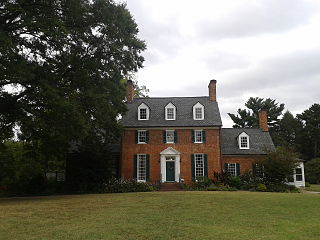
Green Spring Gardens is a public park, including a historic 18th-century plantation house "Green Spring", which is the heart of a national historic district listed on the National Register of Historic Places in 2003. The Fairfax County Park Authority operates Green Spring with the assistance of various nonprofit organizations concerned with history and gardening. Open daily without charge, the street address is 4603 Green Spring Road, Alexandria, Virginia.

Smith's Fort Plantation is a house and parcel of land located in Surry County, Virginia, United States. The current main house on the property, also known as the Faulcon House, dates from 1751. The house has been an example for numerous twentieth century reproductions. It is also known as Warren House and Rolfe-Warren House.
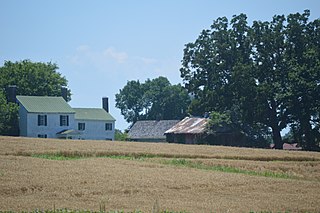
Brandon Plantation is a historic plantation home located near Alton, Halifax County, Virginia. The main house is a two-part, frame vernacular farmhouse. The earliest section of the farmhouse is a single-pile, three-bay gable-roof dwelling erected about 1800. Attached to the east end is a two-bay section added about 1842. The interior features details attributed to Thomas Day, a well-known African-American cabinetmaker from Milton, North Carolina. The farmhouse underwent an extensive remodeling and modernization in the early 1960s but preserves a significant degree of architectural integrity. Also on the property are a contributing frame kitchen / slave quarter outbuilding, an early stone-lined well, and the sites of early agricultural outbuildings.
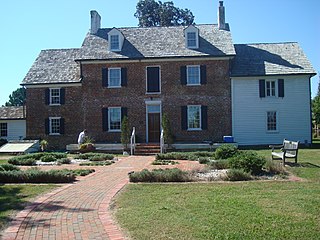
Ferry Plantation House, or Old Donation Farm, Ferry Farm, Walke Manor House, is a brick house in the neighborhood of Old Donation Farm in Virginia Beach, Virginia. The site dates back to 1642 when Savill Gaskin started the second ferry service in Hampton Roads to carry passengers on the Lynnhaven River to the nearby county courthouse and to visit plantations along the waterway. A cannon was used to signal the ferry, which had 11 total stops along the river. The first ferry service was started nearby by Adam Thoroughgood.

Limestone, also known as Limestone Plantation and Limestone Farm, has two historic homes and a farm complex located near Keswick, Albemarle County, Virginia. The main dwelling at Limestone Farm consists of a long, narrow two-story central section flanked by two wings. the main section was built about 1840, and the wings appear to be two small late-18th-century dwellings that were incorporated into the larger building. It features a two-story porch. The house underwent another major renovation in the 1920s, when Colonial Revival-style detailing was added. The second dwelling is the Robert Sharp House, also known as the Monroe Law Office. It was built in 1794, and is a 2+1⁄2-story, brick and frame structure measuring 18 feet by 24 feet. Also on the property are a contributing shed (garage), corncrib, cemetery, a portion of a historic roadway, and a lime kiln known as "Jefferson's Limestone Kiln" (1760s). Limestone's owner in the late-18th century, Robert Sharp, was a neighbor and acquaintance of Thomas Jefferson. The property was purchased by James Monroe in 1816, after the death of Robert Sharp in 1808, and he put his brother Andrew Monroe in charge of its administration. The property was sold at auction in 1828.
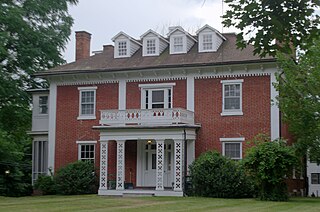
Rosedale Historic District is a national historic district located at Covington, Alleghany County, Virginia. The district encompasses 76 contributing buildings, 1 contributing site, and 2 contributing structures in a predominantly residential section of Alleghany County. The buildings represent a variety of popular architectural styles including the Queen Anne, Greek Revival, and Classical Revival styles. The most notable residence is Rose Dale, constructed in the late-1850s as a plantation house. The Rosedale neighborhood was in established in 1899–1900. In addition to the dwellings a former hospital is situated in the district.

Hazelwood is a historic archaeological site located at Port Royal, Caroline County, Virginia. It was the site of the historic house and plantation "Hazelwood", home of political economist and U.S. Senator John Taylor of Caroline (1753-1824). The house was built about 1750 and destroyed during the American Civil War.

Ben Dover, also known as Ben Dover Farm, is a historic home and plantation complex, recognized as a national historic district, located near Manakin-Sabot in Goochland County, Virginia, United States. The district encompasses 13 contributing buildings, 8 contributing sites, and 10 contributing structures. The main dwelling was built in 1853 as a villa or the Big House of the plantation, in an Italianate style. When renovated in 1930, it was transformed when given a Colonial Revival facade to mask decades of deterioration and poor patchwork.

Powhatan Rural Historic District, formerly "Powhatan Hill Plantation" and before that "Hopyard Plantation", is a national historic district located near King George, King George County, Virginia. It encompasses 15 contributing buildings, 1 contributing site, and 3 contributing structures in a rural area near King George. The district represents a significant reassemblage of the land holdings of Edward Thornton Tayloe, a member of the U.S. diplomatic service under Joel Roberts Poinsett, in the mid-19th century and one of Virginia's most affluent planters of that era; who inherited it from his father John Tayloe III, who built The Octagon House in Washington DC, and it was known then as 'Hopyard,' he inherited it from his father John Tayloe II who built the grand colonial estate Mount Airy. It contains three distinct historic residential farm clusters as well as two post-1950 stable complexes and several other auxiliary residential and agricultural buildings. The main house, known as Powhatan, is sited prominently on a ridge overlooking the Rappahannock River valley.
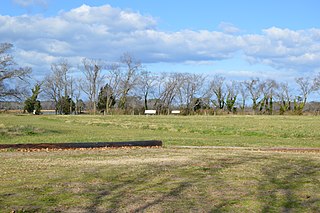
Arlington Archeological Site is a historic archaeological site located near Capeville, Northampton County, Virginia. It is located east of the Custis Tombs. The site includes archaeological features ranging from Accomack Plantation, the first English settlement of the Eastern Shore in 1619, to probable tenant or slave quarter features dating to the second half of the 18th century. The site also includes the foundations of Arlington mansion, established about 1670 and demolished about 1720. Arlington plantation was the ancestral home of the Custis family of Virginia. Archaeological investigations and excavations of the site were conducted in 1987-1988 and 1994.

Stirling, also known as Stirling Plantation, is a historic plantation house located near Massaponax, Spotsylvania County, Virginia. It was built between 1858 and 1860, and is a 2+1⁄2-story, five-bay, brick Greek Revival and Federal dwelling. It measures 56 feet by 36 feet, and has a hipped roof and four interior end chimneys. It sits on a raised basement and features entrance porches added about 1912. Also on the property are the contributing kitchen dependency, smokehouse, family cemetery, and the undisturbed archaeological sites of a weaving house and three slave cabins.

Conjurer's Neck Archeological District is a set of two historic archaeological sites and national historic district located at Colonial Heights, Virginia. The district includes the previously listed Conjurer's Field Archeological Site prehistoric village site (44CF20) and the site of a Colonial-period plantation house, known as the Kennon House or Old Brick House (44CF646). The original house was built between 1725 and 1750, and rebuilt in 1879 after a fire. The site possesses undisturbed and stratified cultural features dating to the late 1700s and afterward.

Chesterville Plantation Site is a historic archaeological site located on the grounds of NASA Langley Research Center in Hampton, Virginia. The main house was built about 1771, and was a two-story brick house set on a high basement, with a three-bay gable end front, and stuccoed brick walls. The site includes the remains of the house, the ruins of a building with a ballast stone foundation, the foundation of a brick kiln, a cemetery, and scattered evidence of 17th century occupation. In 1755 George Wythe (1726-1806) inherited the property believed to have been his birthplace, and built the Chesterville Plantation house about 1771. It was his primary place of residence until 1775 and he continued to operate a plantation there until 1792. The mansion was destroyed by fire in 1911.

Arnheim is a historic plantation house located at Radford, Virginia. It was built between 1838 and 1840, and is a two-story, three-bay, Federal / Greek Revival–style brick dwelling. It is a symmetrical double-pile plan dwelling, 40 feet square, and sitting on a raised brick basement. In 1939, it was converted into a home economics annex for the adjacent Radford High School. Arnheim was built by Dr. John Blair Radford, for whom the City of Radford is named. The property also includes a documented contributing archaeological site.

Walnut Valley is a historic plantation house and archaeological site located near Highgate, Surry County, Virginia. The property includes a plantation house, a frame slave quarter (1816), a frame kitchen (1816), seven contributing 19th- and 20th-century agricultural and domestic outbuildings and structures, and an archaeological site. The house is a 1+1⁄2-story, four-bay, double-pile, side-gabled frame house on a brick foundation. It measures 40 feet, 4 inches, by 30 feet, 5 inches and features Federal style decorative elements. The one-story, two-bay frame slave quarter measures 14 feet by 16 feet, and is clad in weatherboard. The contributing outbuildings include a late-19th century storehouse and a granary, well house, silo, and three chicken houses. The property was conveyed to the Commonwealth of Virginia for the Virginia Department of Conservation and Recreation on January 14, 2004. It is now contained within Chippokes Plantation State Park.

Springdale is a historic plantation house located near Mathews, Mathews County, Virginia. The original section of the house may date to about 1750. Originally the house was a frame Georgian style two-story, side-passage gambrel roof dwelling with a brick cellar. A one-story shed addition was added in the late-18th or early-19th century. This section of the house was renovated between about 1774 and 1824. The house was expanded by 1840, with a 2+1⁄2-story, Federal style south wing and 1+1⁄2-story hyphen connecting the two wings. Also on the property is a contributing smokehouse and archaeological site.

Bowyer-Holladay House, also known as the Lewis Holladay House, is a historic archaeological site located near Fincastle, Botetourt County, Virginia. The site is located in The Botetourt Center at Greenfield industrial park. The site consists of the ruins of an Early Republic/Federal Style two-story brick house with a limestone lined cellar in a rear-centered ell configuration. The house was part of the plantation complex commonly referred to as the "Holladay Place." In addition to the ruins of the main house, a log structure with an early timber and modern frame addition survives 25 feet north of the bulkhead entrance to the limestone cellar.

The Birthplace of Patrick Henry (1736–1799), the Founding Father and American statesman from Virginia, was a farmhouse called "Studley", located in what is now the village of Studley in Hanover County, Virginia. The house, a two-story brick structure, was built in the 1720s by John Symes, whose wife Sarah married Patrick Henry's father John after Symes died. Patrick Henry was born in the house on May 29, 1736. By 1796 the farmstead included a significant number of outbuildings. The house was destroyed by fire in 1807, and now only archaeological remnants remain.
























